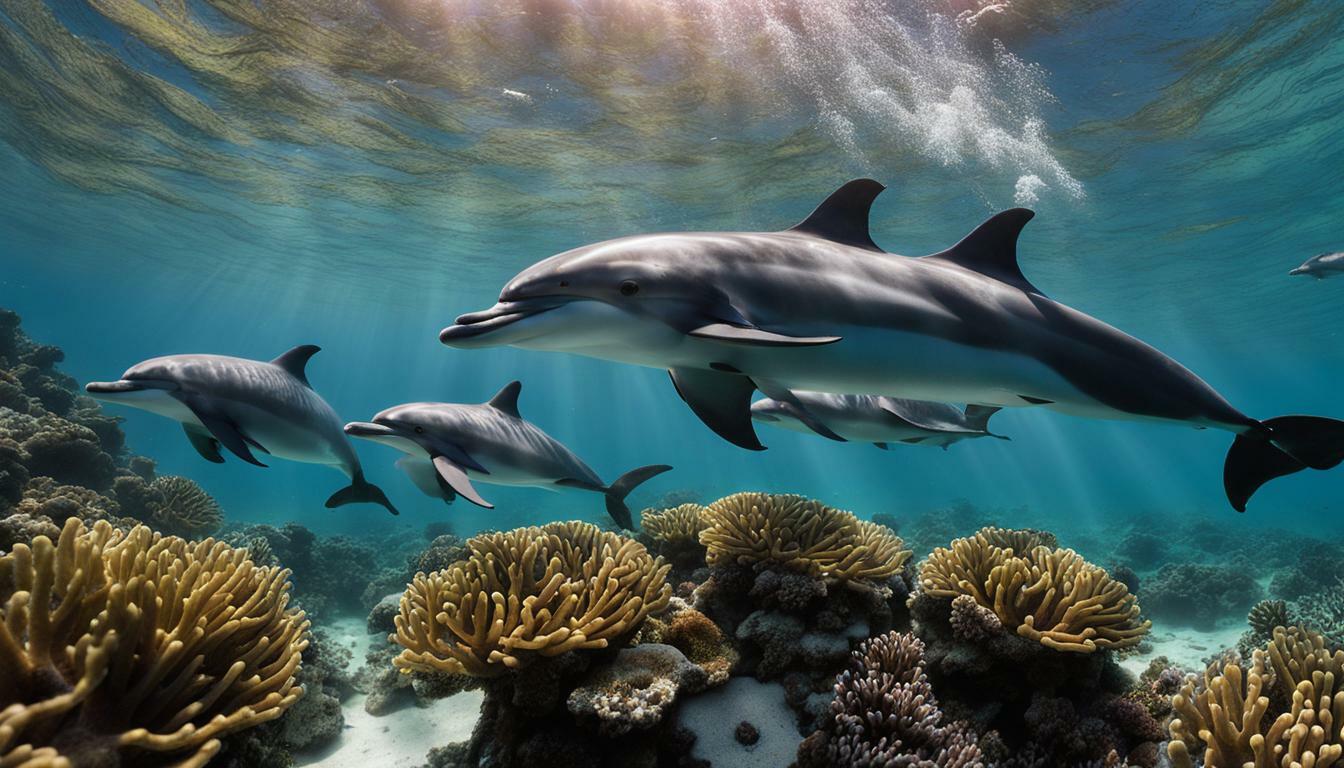Dolphins possess remarkable physical characteristics and adaptations that make them perfectly suited for life in the water. Their streamlined body shape reduces drag and allows them to swim efficiently at high speeds for short bursts, as well as lower speeds for longer periods of time. With a blowhole on top of their heads, dolphins can exchange a high percentage of lung air during each respiration. This enables them to dive to various depths, with some species capable of reaching depths up to 390 meters.
In addition to their incredible swimming abilities, dolphins have adaptations for thermoregulation, ensuring their survival in varying water temperatures. They have a decreased surface-to-volume ratio, which helps maintain body heat. Dolphins also have a layer of blubber for increased insulation and a heat exchange system. These adaptations allow them to thrive in different environments.
The external anatomy of dolphins is specifically designed to support their aquatic lifestyle. They have a fusiform body shape, smooth skin, flippers for steering, a dorsal fin for stability, and tail flukes for propulsion. Internally, dolphins have a modified skeleton, a specialized respiratory system for diving, and a complex cardiovascular system. This unique combination of physical traits and adaptations contributes to their overall success in the marine environment.
Dolphins are carnivorous and use their teeth to seize their food. They have an intricate communication system that utilizes underwater sonar and echolocation for navigation and hunting. These sensory abilities, combined with their excellent vision adapted for underwater conditions, make dolphins highly skilled predators.
Reproduction in dolphins is sexual, with females reaching sexual maturity at different ages depending on the species and gender. They have a gestation period of 11-12 months and give birth to a single calf. Nursing their young with milk, female dolphins provide the necessary care for their offspring.
In conclusion, dolphins’ physical characteristics and adaptations are truly remarkable. From their streamlined body shape and efficient swimming abilities to their thermoregulation and sensory abilities, dolphins are perfectly equipped for life in the water. By exploring and understanding these unique traits, we can further appreciate the extraordinary nature of these incredible marine creatures.
Streamlined Body Shape and Efficient Swimming
One of the key physical traits of dolphins is their streamlined body shape, which enables them to swim through the water with remarkable speed and agility. Their bodies are elongated and tapered, reducing drag and allowing them to move effortlessly through the ocean. This streamlined shape is enhanced by the smooth contour of their skin, eliminating any protruding or irregular features that could slow them down.
Dolphins also possess a unique physiological adaptation known as a fusiform body. This means that their bodies are cylindrical in shape, with a slim midsection and a tapering towards the rear. The fusiform body minimizes turbulence as water flows around the dolphin, reducing resistance and allowing for efficient swimming. This adaptation enables dolphins to reach high speeds when necessary, making them highly efficient hunters and active predators in their marine environment.
In addition to their streamlined body shape, dolphins have other physical features that contribute to their swimming abilities. They have powerful tails, known as flukes, which generate propulsion as they move through the water. The muscles in their flukes are strong and well-developed, providing the force needed for rapid acceleration and quick turns. Along with their flippers, which act as stabilizers and steering mechanisms, dolphins have a perfectly designed body that allows them to navigate their underwater world with precision.
Table: Dolphin Physical Traits
| Physical Trait | Description |
|---|---|
| Streamlined Body Shape | Elongated and tapered bodies that reduce drag and enable efficient swimming. |
| Fusiform Body | Cylindrical shape that minimizes turbulence and provides efficiency in movement. |
| Powerful Tails (Flukes) | Muscular tails that generate propulsion and allow for rapid acceleration and maneuverability. |
| Flippers | Act as stabilizers and steering mechanisms, aiding in precise navigation. |
Dolphins have honed their physical traits over millions of years of evolution, allowing them to thrive in their aquatic habitats. Their streamlined body shape, fusiform bodies, powerful tails, and flippers all contribute to their exceptional swimming abilities. By adapting to their environment in this way, dolphins have become one of the most efficient and agile swimmers in the animal kingdom.
Adaptations for Breathing and Diving
Dolphins possess remarkable adaptations for breathing and diving, which help them thrive in their oceanic habitat. These physical attributes enable them to navigate the depths of the ocean and efficiently obtain the oxygen they need to sustain their active lifestyle. One of the key adaptations is their blowhole, located on top of their heads, allowing them to breathe while maintaining their streamlined body shape. This unique feature allows dolphins to take quick, efficient breaths at the water’s surface without slowing down.
Dolphins are also equipped with a specialized respiratory system that enables them to dive to various depths. By reducing their heart rate and redirecting blood flow, they conserve oxygen during a dive and can stay underwater for extended periods. Some species of dolphins are capable of diving up to 390 meters, demonstrating their exceptional ability to adapt to the demands of their environment.
Another crucial adaptation for diving is their thermoregulation system. Dolphins have a decreased surface-to-volume ratio, which helps them retain heat in colder water. Additionally, they have a thick layer of blubber that acts as insulation, preventing heat loss and providing buoyancy. Furthermore, dolphins possess a unique heat exchange system in their circulatory system, allowing them to retain warm blood in their vital organs while cooling blood in their extremities.
| Adaptation | Function |
|---|---|
| Blowhole | Enables quick and efficient breathing at the water’s surface |
| Specialized Respiratory System | Allows efficient oxygen conservation during dives |
| Thermoregulation System | Helps dolphins retain heat in colder water and prevent heat loss |
| Heat Exchange System | Enables dolphins to retain warm blood in vital organs while cooling blood in extremities |
In conclusion, dolphins have evolved incredible adaptations to excel in their underwater world. Their ability to breathe efficiently while diving, along with their specialized respiratory and thermoregulation systems, allows them to adapt and thrive in various oceanic environments. These remarkable survival traits contribute to the enduring success of dolphins as a species.
Thermoregulation and Adaptations for Temperature Control
Dolphins possess fascinating morphological and physiological adaptations that allow them to regulate their body temperature and adapt to varying water conditions. These unique traits enable them to thrive in a wide range of environments, from the frigid waters of the Arctic to the warm tropical seas.
One of the key adaptations for thermoregulation in dolphins is their decreased surface-to-volume ratio. This means that they have a smaller surface area relative to their body size, minimizing heat loss to the surrounding water. Additionally, dolphins have a thick layer of blubber, which acts as effective insulation to retain body heat in colder temperatures.
Dolphins also have a sophisticated heat exchange system that helps them regulate their internal temperature. Their blood vessels are arranged in a complex network called the rete mirabile, which allows for efficient transfer of heat between the arteries and veins. In warmer waters, the rete mirabile helps dissipate excess heat, while in colder waters, it aids in heat retention.
Furthermore, dolphins engage in behavioral adaptations to maintain their body temperature. They often swim in groups, which provides social warmth and allows them to conserve energy. They may also utilize shallow, sunlit areas to bask and warm up their bodies.
| Thermoregulation Adaptations | Description |
|---|---|
| Decreased surface-to-volume ratio | Reduces heat loss to the surrounding water. |
| Thick layer of blubber | Acts as insulation in colder temperatures. |
| Rete mirabile | A complex network of blood vessels for efficient heat exchange. |
| Behavioral adaptations | Swimming in groups and utilizing sunlit areas for warmth. |
Overall, the thermoregulatory adaptations of dolphins are remarkable and demonstrate their ability to survive in diverse aquatic environments. These adaptations, combined with their streamlined body shape and efficient swimming abilities, make dolphins truly extraordinary creatures of the sea.
Anatomy and Specialized Systems
Dolphins have a unique anatomical structure, including specialized systems, that supports their adaptation to life in the water. Their body shape, skin, fins, and internal organs are all finely tuned to optimize their ability to swim, hunt, communicate, and survive in their marine environment.
Externally, dolphins have a streamlined body shape, also known as “fusiform,” which reduces drag and allows them to move swiftly through the water. Their smooth skin helps them glide effortlessly, minimizing resistance and conserving energy during swimming. The flippers located on their sides act as steering mechanisms, enabling precise maneuverability, while the dorsal fin provides stability by counteracting roll and pitch movements.
Internally, dolphins possess a modified skeleton that supports their aquatic lifestyle. Their ribcage is flexible, allowing them to expand their lungs for increased oxygen intake during deep dives. Dolphins have a specialized respiratory system that enables them to hold their breath underwater for extended periods. Their complex cardiovascular system efficiently delivers oxygenated blood to the muscles, ensuring sustained swimming endurance.
Furthermore, dolphins have a unique heat exchange system that helps regulate their body temperature in different water conditions. They have a decreased surface-to-volume ratio, minimizing heat loss. Additionally, a layer of blubber beneath their skin provides insulation, preventing heat dissipation. These adaptations allow dolphins to thrive in both warm and cold waters and maintain optimal internal body temperatures.
| External Anatomy | Internal Anatomy |
|---|---|
| Fusiform body shape | Modified skeleton |
| Smooth skin | Specialized respiratory system |
| Flippers for steering | Complex cardiovascular system |
| Dorsal fin for stability | Heat exchange system |
| Tail flukes for propulsion |
“Dolphins have a unique anatomical structure that allows them to thrive in their marine environment. Their streamlined body shape, flexible ribcage, and specialized respiratory and cardiovascular systems all contribute to their efficiency as swimmers. Their external features, such as smooth skin, flippers, and dorsal fin, enhance their ability to navigate and maintain stability. Internally, dolphins have a modified skeleton, a complex respiratory system, and a heat exchange mechanism that enables them to adapt to varying water temperatures. These anatomical characteristics are crucial to their survival and success as highly adapted marine mammals.”
Another remarkable aspect of dolphin anatomy is their sensory abilities. Their eyes are adapted for vision in underwater conditions, allowing them to see clearly even in low light. Moreover, dolphins possess a sophisticated communication system that utilizes underwater sonar and echolocation. These adaptations enable them to locate prey, navigate their environment, and communicate effectively with other members of their pod.
In conclusion, the unique anatomical structure of dolphins, along with their specialized systems, supports their adaptation to life in the water. Their streamlined body shape, smooth skin, and fin structures optimize their swimming abilities and maneuverability. Internally, their modified skeleton, respiratory and cardiovascular systems, and heat exchange mechanism allow them to thrive in different water temperatures. With exceptional sensory abilities and communication systems, dolphins are truly remarkable creatures, perfectly suited for their marine habitats.
Reproduction, Sensory Abilities, and Conclusion
Dolphins possess incredible survival traits, including their reproductive strategies and exceptional sensory abilities, which ultimately contribute to their adaptation and success in their marine habitats. Their ability to reproduce plays a crucial role in sustaining their population. Females have a gestation period of 11-12 months and give birth to a single calf. This prolonged period of pregnancy ensures the development of a strong and healthy offspring. After birth, the females nurse their young with milk, providing essential nutrients for their growth and development.
Furthermore, dolphins display remarkable sensory abilities that enable them to navigate and communicate effectively underwater. Their vision is adapted for the unique conditions of the marine environment, allowing them to see clearly even in murky waters. This heightened visual perception helps them locate prey and avoid potential dangers. In addition to vision, dolphins also possess the remarkable ability of echolocation, which involves emitting sounds and using the echoes to detect objects and navigate their surroundings. This sensory skill allows them to navigate, locate prey, and communicate with other members of their pod.
In conclusion, the reproductive strategies and exceptional sensory abilities of dolphins are key factors in their adaptation and success in the marine habitats they inhabit. The ability to reproduce and nurture their young ensures the continuation of their species, while their sensory skills enable them to thrive in the complex underwater environment. By understanding and appreciating these survival traits, we gain a deeper insight into the incredible nature of dolphins and the remarkable adaptations that have allowed them to flourish in the oceans for millions of years.
| Survival Traits | Reproduction | Sensory Abilities |
|---|---|---|
| Key factors in adaptation and success | Gestation period of 11-12 months | Heightened visual perception |
| Ensure continuation of species | Birth of a single calf | Echolocation for navigation and prey detection |
| Nursing with milk |
How Do Dolphins’ Physical Characteristics Vary Across Their Geographical Distribution?
The global distribution patterns of dolphins reveal intriguing variations in their physical characteristics. From the streamlined bodies of oceanic dolphins in tropical regions to the robust build of coastal dolphins in colder climates, their adaptation to diverse environments is remarkable. These variations illustrate the fascinating interplay between geography and the physical traits of these majestic marine mammals.
Conclusion
In conclusion, the physical characteristics and adaptations of dolphins truly showcase their incredible ability to adapt and thrive in their oceanic habitats. Dolphins are highly efficient swimmers, capable of swimming at high speeds for short bursts and lower speeds for longer periods of time. Their streamlined body shape reduces drag and allows them to move through the water with agility. They have a blowhole on top of their heads, enabling them to exchange a high percentage of lung air during each respiration.
Dolphins also have remarkable adaptations for diving, with some species capable of reaching depths of up to 390 meters. Their thermoregulation abilities, including a decreased surface-to-volume ratio, increased insulation through a layer of blubber, and a heat exchange system, enable them to thrive in varying water temperatures. Additionally, dolphins engage in sleep, dedicating about 33% of each day to resting and rejuvenating.
The external anatomy of dolphins is perfectly suited for their aquatic lifestyle. Their fusiform body shape, smooth skin, flippers for steering, dorsal fin for stability, and tail flukes for propulsion all contribute to their exceptional swimming abilities. Internally, dolphins have a modified skeleton, specialized respiratory system for diving, and complex cardiovascular system.
Dolphins are carnivorous, using their teeth to seize their food, and have an intricate communication system through underwater sonar and echolocation. Reproduction is sexual, with females having a gestation period of 11-12 months and giving birth to a single calf. They further nurture their young through nursing with milk. Dolphins possess excellent sensory abilities, including vision adapted for underwater conditions.











